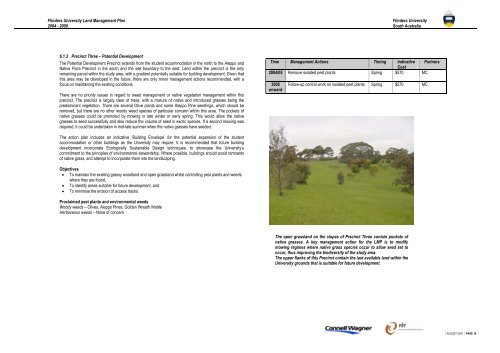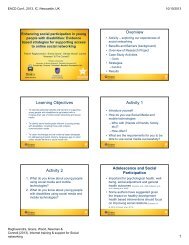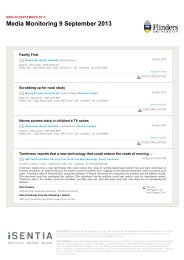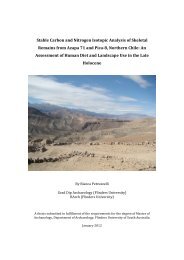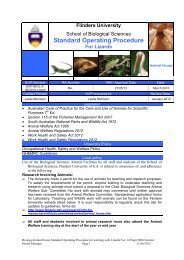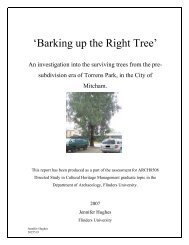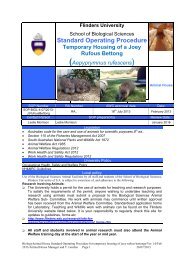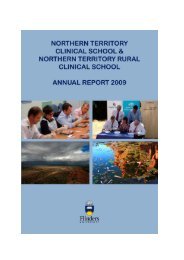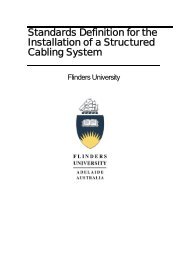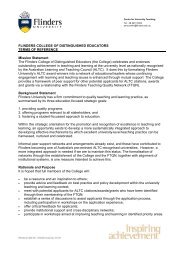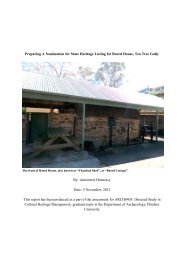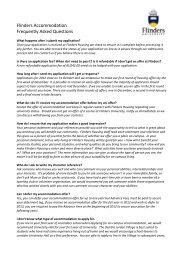Land Management Plan 2004 - 2050 Flinders University South ...
Land Management Plan 2004 - 2050 Flinders University South ...
Land Management Plan 2004 - 2050 Flinders University South ...
You also want an ePaper? Increase the reach of your titles
YUMPU automatically turns print PDFs into web optimized ePapers that Google loves.
<strong>Flinders</strong> <strong>University</strong> <strong>Land</strong> <strong>Management</strong> <strong>Plan</strong> <strong>Flinders</strong> <strong>University</strong><br />
<strong>2004</strong> - <strong>2050</strong> <strong>South</strong> Australia<br />
6.1.3 Precinct Three – Potential Development<br />
The Potential Development Precinct extends from the student accommodation in the north to the Aleppo and<br />
Native Flora Precinct in the south and the site boundary to the east. <strong>Land</strong> within the precinct is the only<br />
remaining parcel within the study area, with a gradient potentially suitable for building development. Given that<br />
this area may be developed in the future, there are only minor management actions recommended, with a<br />
focus on maintaining the existing conditions.<br />
There are no priority issues in regard to weed management or native vegetation management within this<br />
precinct. The precinct is largely clear of trees, with a mixture of native and introduced grasses being the<br />
predominant vegetation. There are several Olive plants and some Aleppo Pine seedlings, which should be<br />
removed, but there are no other woody weed species of particular concern within this area. The pockets of<br />
native grasses could be promoted by mowing in late winter or early spring. This would allow the native<br />
grasses to seed successfully and also reduce the volume of seed in exotic species. If a second mowing was<br />
required, it could be undertaken in mid-late summer when the native grasses have seeded.<br />
Time <strong>Management</strong> Actions Timing Indicative Partners<br />
Cost<br />
<strong>2004</strong>/05 Remove isolated pest plants Spring $570 MC<br />
2005<br />
onward<br />
Follow-up control work on isolated pest plants Spring $570 MC<br />
The action plan includes an indicative ‘Building Envelope’ for the potential expansion of the student<br />
accommodation or other buildings as the <strong>University</strong> may require. It is recommended that future building<br />
development incorporate Ecologically Sustainable Design techniques, to showcase the <strong>University</strong>’s<br />
commitment to the principles of environmental stewardship. Where possible, buildings should avoid remnants<br />
of native grass, and attempt to incorporate them into the landscaping.<br />
Objectives<br />
• To maintain the existing grassy woodland and open grassland whilst controlling pest plants and weeds<br />
where they are found,<br />
• To identify areas suitable for future development, and<br />
• To minimise the erosion of access tracks.<br />
Proclaimed pest plants and environmental weeds<br />
Woody weeds – Olives, Aleppo Pines, Golden Wreath Wattle<br />
Herbaceous weeds – None of concern<br />
The open grassland on the slopes of Precinct Three contain pockets of<br />
native grasses. A key management action for the LMP is to modify<br />
mowing regimes where native grass species occur to allow seed set to<br />
occur, thus improving the biodiversity of the study area.<br />
The upper flanks of this Precinct contain the last available land within the<br />
<strong>University</strong> grounds that is suitable for future development.<br />
⏐ AUGUST <strong>2004</strong> ⏐ PAGE 19


